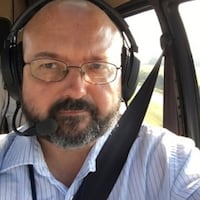Or they planned a rescue mission in the mountains of Chile.
Or they co-piloted a single-engine plane from the Dayton-Wright Brothers Airport.
Air Camp is a weeklong educational experience for youths about to enter 7th, 8th and 9th grades in the fall. It’s meant to strengthen interest in STEM (science, technology, engineering and math) subjects by showing how those subjects intersect with aviation and aeronautics — the joy of flying.
A group of STEM supporters and aviation enthusiasts came up with the idea in 2004, and Amanda Wright Lane, the Wright Brothers’ great grand niece, was an early supporter. They created a non-profit 501(C)3 organization, and this summer will be Air Camp’s third offering the sessions, said Mona Vollmer, Air Camp deputy executive director
What Space Camp is to rocket science and space exploration, Air Camp seeks to be to aviation, Vollmer said.
“We want to be as big as Space Camp,” Vollmer said.
And Space Camp is big. Since 1982, some 500,000 students have experienced Space Camp, that organization says.
This summer’s first Air Camp session graduated Friday. A few openings still remain for the July 8-13 session, organizers said. (Those interested may go to the Air Camp web site, www.AirCampUSA.com.)
This summer’s first session of 40 students drew participants from 15 states, including California and Oregon. They were housed at the University of Dayton. Any typical day might have taken them to the Air Force Research Laboratory, the 445th Air Wing at Wright-Patterson Air Force Base, the Boonshoft Museum of Discovery or other places.
The STEM thread runs through the entire week, whether participants are on a “scavenger hunt” at the National Museum of the U.S. Air Force or a flight simulator at Sinclair Community College.
Students are expected to pay attention; they often must document their experiences with data sheets or digital cameras. A group of 10 people, six with doctoral degrees, designed the Air Camp curriculum.
“We make it a ‘wow’ experience,” said Dick Reynolds, a retired Air Force lieutenant general and Air Camp secretary.
In a sense, there is no “typical” day for Air Camp participants.
“There is a lot of excitement,” said Tom Severyn, Air Camp executive director and former acting director of the F-22 program. “They’re just bouncing off the walls. Some of that is being kids, but a lot of that is what they’re seeing.”
Tuition is $995, but 20 percent of participating students get scholarships, organizers said. And the cost is three times what the organization charges, they said. Contributions to Air Camp and in-kind assistance are crucial to keeping the camp going.
But organizers feel the endeavor fits perfectly with a city that holds itself as the birthplace of aviation.
“We feel we’ve had a hand already in all the great things that Dayton does,” Reynolds said.
Contact this reporter at (937) 225-2390 or tgnau @DaytonDailyNews.com.
About the Author
